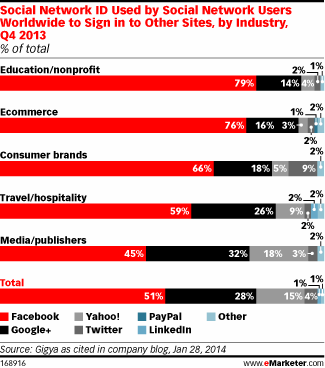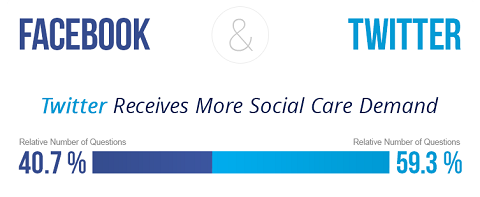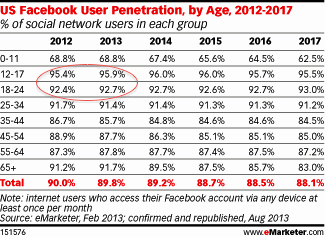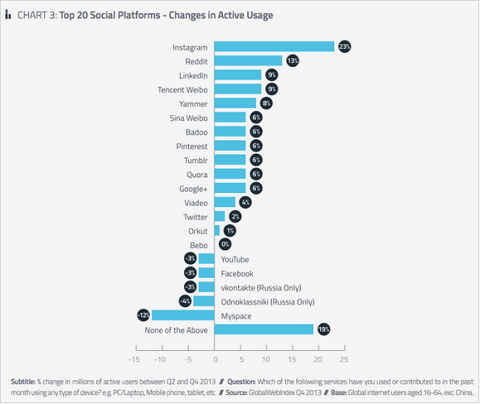 Are you managing social media for your business?
Are you managing social media for your business?
Do you pay attention to the trends happening across the social web?
If so, you already know how the rules and landscape of social media marketing are always changing.
But what you don't know may not only surprise you, but also may make you think twice about your social media strategy.
Here are four surprising social media research findings you should leverage for your social media strategy.
#1: Users ‘Like' Facebook for Social Logins
When logging onto sites with a social network ID, research by eMarketer shows that a majority of users (51%) prefer to log in using their Facebook credentials.
In fact, professionals across all industries favored Facebook. Only 28% of users log in with Google+. Facebook is also the preferred social login network ID for 63% of global mobile users.

Key Takeaways:
If you have a website that requires users to register, you should understand the concept of password fatigue. 92% of shoppers abandon a website rather than go through the process of recovering a lost or forgotten password. But if a website has a social login option, 65% of shoppers are more likely to return.
So if you have an ecommerce site and you let folks use Facebook to log in, then you already know their likes and interests. Use that information to personalize their experience:
- When they log into your website, offer them products that they actually like or have shown interest in to improve the chances of purchasing. In fact, one of the benefits of social login is that it limits the incidence of mistargeted ads.
- While they're logged onto your site, they're simultaneously logged onto Facebook, which means they can share a useful post or comment on a cool product. Make sure they find fresh, interesting, and shareworthy content every time they log in.
- Users want value in exchange for giving up their personal information on your site. So offer them premium content such as training videos, SlideShare presentations, free ebooks and how-to guides.
- To enhance brand interaction and social visibility, offer a community message board on your website that is only accessible to members who are logged in.
#2: Social Customer Care Demand Is Growing on Twitter
When it comes to social customer service (or social customer care), Twitter is becoming the place to be for consumers who want to reach out to brands. Research by Socialbakers indicates that 59.3% of customer questions are asked on Twitter, compared to 40.7% on Facebook.

Key Takeaways:
Social media has conditioned consumers to get feedback fast. As a marketer, the risk of failing to meet this expectation can result in losing customers, getting a bad reputation or both.
Get World-Class Marketing Training — All Year Long!
Are you facing doubt, uncertainty, or overwhelm? The Social Media Marketing Society can help.
Each month, you’ll receive training from trusted marketing experts, covering everything from AI to organic social marketing. When you join, you’ll also get immediate access to:
- A library of 100+ marketing trainings
- A community of like-minded marketers
- Monthly online community meetups
- Relevant news and trends updates
- Twitter is especially fast-paced, so here are some tips to providing customer care on that platform:
- Train and empower your staff to respond promptly and directly to customers. If you can't trust them to respond appropriately on behalf of the company, then you either have the wrong team or the wrong strategy.
- Don't let customer complaints or questions go unanswered for over an hour. If you wait too long, the customer (or prospect) may decide to move on to a more responsive vendor.
- If you have to use your brand's logo, try to personalize each response by signing each tweet with your name or Twitter handle.
- Don't just monitor mentions of your brand's name. Try to evaluate sentiments attached to those mentions. Tweets that include words like “not working,” “fail” or “poor experience” should be resolved immediately, and to the customer's full satisfaction.
- Know when to jump into a conversation. Sometimes customers are just talking about your brand and don't actually need your help or input.
- Decide how to prioritize inquiries. Should influencers get priority over urgent customer needs or will you use a first-come, first-served approach?
#3: Younger Audiences Are NOT Unfriending Facebook
There's been a lot of talk lately about teens unfriending Facebook. Turns out it's not quite true.

Discover Proven Marketing Strategies and Tips
Want to go even deeper with your marketing? Check out the Social Media Marketing Podcast! Publishing weekly since 2012, the Social Media Marketing Podcast helps you navigate the constantly changing marketing jungle, with expert interviews from marketing pros.
But don’t let the name fool you. This show is about a lot more than just social media marketing. With over 600 episodes and millions of downloads each year, this show has been a trusted source for marketers for well over a decade.
Facebook has indeed lost its exclusive grip on teens. Young audiences are flocking to more visual platforms like Snapchat, Instagram and Vine; however, these stats from eMarketer speak for themselves:

Key Takeaways:
Like everybody else, teens and younger audiences have become multiple-platform users. That doesn't mean they're done with Facebook, it just means that their social interests are broadening.
Consider this: teens are particularly interested in image and video sharing. Sure, they can share images on Facebook, but they're more comfortable on Snapchat and Instagram where there's less drama—and parents are not present. So if your target audience includes teens and young audiences, don't panic. Instead, try to enhance their experience by following these tips:
- Be everywhere. If teens are important to your business, follow them wherever they go. Create and distribute content across multiple platforms (see #3 in this article). Your brand will be more memorable for young audiences when they see your content across the board on Facebook, Instagram and Snapchat.
- Be relevant. Teens live in an “egosystem,” so the only opinions that matter are their own and their friends' opinions. So whether on or off of Facebook, engage them with stories and visuals that show how other teens like them are interacting with your brand.
- Make it about them. Be very subtle when promoting your product. Instead, focus on what THEY can get out of it. Sweet Frog of Catonsville, MD does this well:

When reaching out to teens on Facebook, make it about them, not you. - Above everything else, make sure ALL of your content is mobile-friendly.
#4: Instagram Is the Fastest-Growing Site Globally
Facebook-owned Instagram may be the platform to watch closely, according to new research published on TechCrunch in January.
Active user base grew by 26% in the last six months of 2013. In addition, available data shows that Instagram had 90 million active users in January 2013. By January 2014, that number had doubled to 180 million active users.

Key Takeaways:
Users love Instagram because images are super-creative and interesting since users can choose filters after the photo has already been taken. But of course the best part is being able to instantly share those photos with a community of like-minded people.
In a previous post, we talked about how marketers can leverage Instagram to promote their brands. Some other tips I would add are:
- Make your followers famous on Instagram by acknowledging their photos and sharing them with your Facebook fans. Starbucks does this well! They even go as far as updating their Facebook cover with Instagram photos created by their fans.

Nobody does it better than Starbucks when it comes to showing off their Instagram followers. - Make videos. Instagram now has short video capability, which means you can create 15-second videos that capture the mood and lifestyle of your brand. For example, if you're launching a new product, take a video of your staff members behind the scenes preparing for launch, or show the actual launch with excited customers waiting for the move that bus moment!
- Partner with other brands on Instagram. Whether you're a small business or a big brand, you can leverage the relationships you have with other businesses by partnering to showcase each other's photos. This works even better if your products are complementary.
- Ask questions about lifestyles. For example, if you're a shoe store, ask followers what kind of outfit and accessories they would wear with a new line of boots.
What do you think? Have these facts helped you identify trends that could change your social media strategy? Please share your thoughts in the comment box below.
Attention Agency Owners, Brand Marketers, and Consultants

Introducing the Marketing Agency Show–our newest podcast designed to explore the struggles of agency marketers.
Join show host and agency owner, Brooke Sellas, as she interviews agency marketers and digs deep into their biggest challenges. Explore topics like navigating rough economic times, leveraging AI, service diversification, client acquisition, and much more.
Just pull up your favorite podcast app, search for Marketing Agency Show and start listening. Or click the button below for more information.

